Oberkommando des Heeres
| Oberkommando des Heeres | |
|---|---|
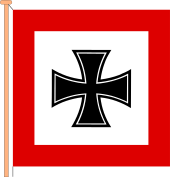 Command flag from 1938 to 1942 | |
| Founded | 1935 |
| Disbanded | 23 May 1945 |
| Country |
|
| Branch |
|
| Type | High Command |
| Part of | Oberkommando der Wehrmacht |
| Nickname(s) | OHK |
| Commanders | |
| Chief of the General Staff | Wilhelm Keitel |
| Insignia | |
| Command flag 1936-38 |
 |
| Command flag 1938-42 |
 |
The Oberkommando des Heeres (OKH) was the High Command (lit. Upper Command) of the German Army during the Era of Nazi Germany. It was founded in 1935 as a part of Adolf Hitler's re-militarisation of Germany. From 1938 OKH was, together with OKL (Oberkommando der Luftwaffe, High Command of the Air Force) and OKM (Oberkommando der Marine, High Command of the Navy), formally subordinated to the OKW (Oberkommando der Wehrmacht, High Command of the Armed Forces), with the exception of the Waffen-SS. During the war, OKH had the responsibility of strategic planning of Armies and Army Groups, while the General Staff of the OKH managed operational matters. Each German Army also had an Armeeoberkommando, Army Command, or AOK. Until the German defeat at Moscow in December 1941, OKH and its staff was de facto the most important unit within the German war planning. OKW then took over this function for theatres other than the German-Soviet front. OKH commander held the title Oberbefehlshaber des Heeres (High Commander of the Army). Following the Battle of Moscow, after OKH commander Field Marshal Walther von Brauchitsch was excused, Hitler appointed himself as Commander-in-Chief of the Army.
OKH vs OKW
Hitler had been the head of OKW since January 1938, using it to pass orders to the navy (OKM), air force (OKL), and army (OKH). After a major crisis developed in the Battle of Moscow, Walther von Brauchitsch was dismissed (partly because of his failing health), and Hitler appointed himself as head of the OKH while still retaining his position at the OKW. At the same time, he limited the OKH's authority to the Russian front, giving OKW direct authority over army units elsewhere. This enabled Hitler to declare that only he had complete awareness of Germany's strategic situation, should any general request a transfer of resources between the Russian front and another theater of operations.[1]
Leadership
Commander-in-Chief of the Army
The Commander-in-Chief of the Army (German: Oberbefehlshaber des Heeres) was the supreme commanding authority of the German Army in times of Nazi Germany. Commanders-in-Chief of the Army were:
| № | Officeholders | Took office | Left office | Time in office | |
|---|---|---|---|---|---|
| 1 | Colonel General Werner von Fritsch (1880–1939) | 1 January 1934 | 4 February 1938 | 4 years, 34 days | |
| 2 | Field Marshal Walther von Brauchitsch (1881–1948) | 4 February 1938 | 19 December 1941 | 3 years, 318 days | |
| 3 | Führer and Reich Chancellor Adolf Hitler (1889–1945) [lower-alpha 1] | 19 December 1941 | 30 April 1945 † | 3 years, 132 days | |
| 4 | Field Marshal Ferdinand Schörner (1892–1973) [lower-alpha 2] | 30 April 1945 | 8 May 1945 | 8 days |
Chief of the OKH General Staff
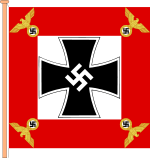
The Chiefs of the OKH General Staff (German: Chef des Generalstabes des Heeres) were:
| № | Chief of Staff | Took office | Left office | Time in office | |
|---|---|---|---|---|---|
| 1 | Colonel General Ludwig Beck (1880–1944) | 1 July 1935 | 31 August 1938 | 3 years, 61 days | |
| 2 | Colonel General Franz Halder (1884–1972) | 1 September 1938 | 24 September 1942 | 4 years, 23 days | |
| 3 | Colonel General Kurt Zeitzler (1895–1963) | 24 September 1942 | 10 June 1944 | 1 year, 260 days | |
| 4 | General Lieutenant Adolf Heusinger (1897–1982) [lower-alpha 3] | 10 June 1944 | 21 July 1944 | 41 days | |
| 5 | Colonel General Heinz Guderian (1888–1954) | 21 July 1944 | 28 March 1945 | 250 days | |
| 6 | General of the Infantry Hans Krebs (1898–1945) [lower-alpha 4] | 1 April 1945 | 1 May 1945 † | 30 days | |
| 7 | Field Marshal Wilhelm Keitel (1882–1946) | 1 May 1945 | 13 May 1945 | 12 days | |
| 8 | Colonel General Alfred Jodl (1890–1946) | 13 May 1945 | 23 May 1945 | 10 days |
Although both OKW and OKH were headquartered in Zossen during the Third Reich, the functional and operational independence of both establishments were not lost on the respective staff during their tenure. Personnel at the sprawling Zossen compound remarked that even if Maybach 2 (the OKW complex) was completely destroyed, the OKH staff in Maybach 1 would scarcely notice. These camouflaged facilities, separated physically by a fence, also maintained structurally different mindsets towards their objectives.
On 28 April 1945 (two days before his suicide), Hitler formally subordinated OKH to OKW, giving the latter command of forces on the Eastern Front.[2]
See also
- German general staff
- Glossary of World War II German military terms
- Maybach I and II
- Oberste Heeresleitung, the German Empire's highest army command during World War I
Notes
- ↑ Hitler assumed personal command of the OKH following Brauchitsch's dismissal in order to supervise Operation Barbarossa, the German-led invasion of the Soviet Union.
- ↑ one of Hitler's favorite military commanders was named in Hitler's last will and testament, which the latter issued prior to his suicide on April 30, 1945 as the new commander of the OKH. Meanwhile, the OKH was subordinated to the OKW of the Wehrmacht, under Field Marshal Wilhelm Keitel.
- ↑ Later served as the Inspector General of the Bundeswehr (1957–1961) and Chairman of the NATO Military Committee (1961–1964)
- ↑ Committed suicide
References
External links
- "Not the Stuff of Legend: The German High Command in World War II" – lecture by Dr. Geoffrey Megargee, author of Inside Hitler's High Command, available at the official YouTube channel of the U.S. Army Heritage and Education Center
.jpg)
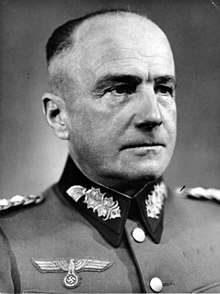
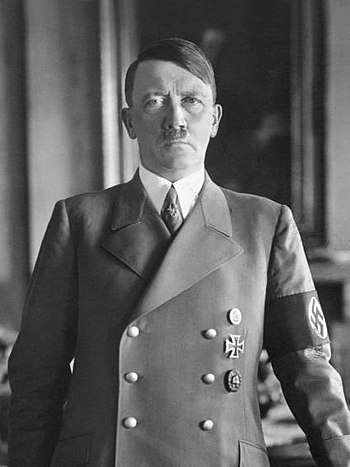
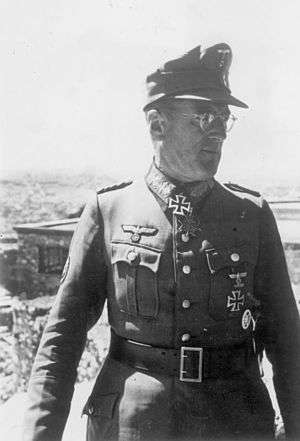

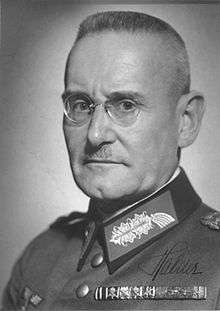
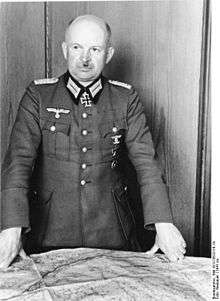
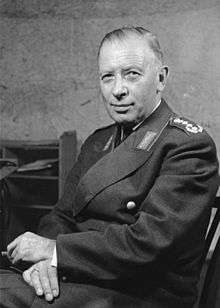
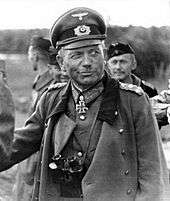

.jpg)
-(a).jpg)